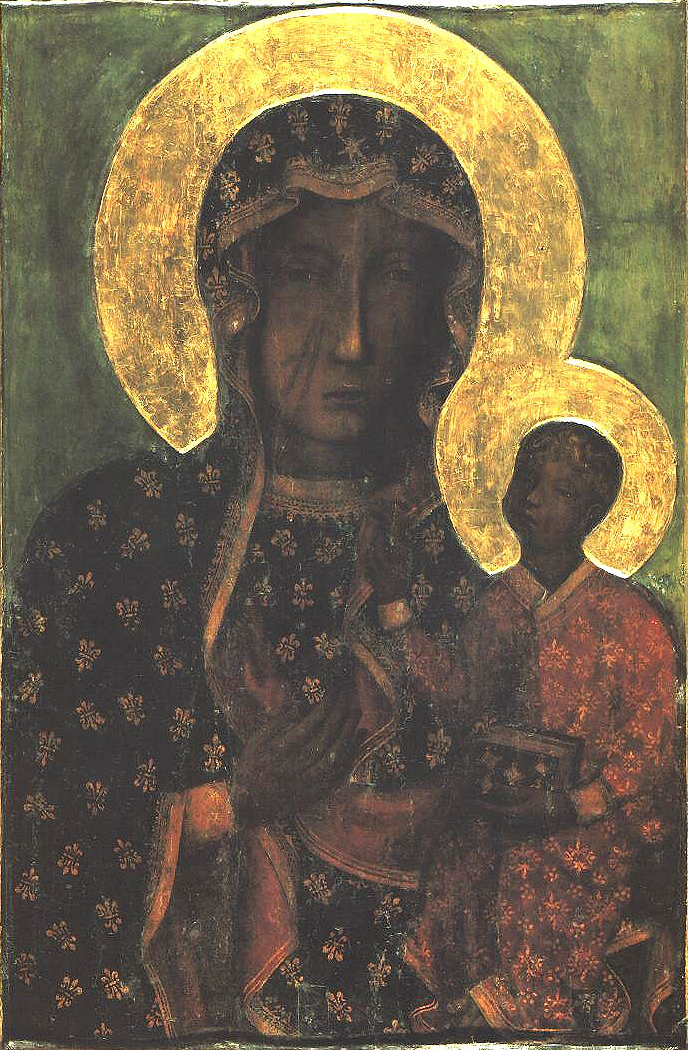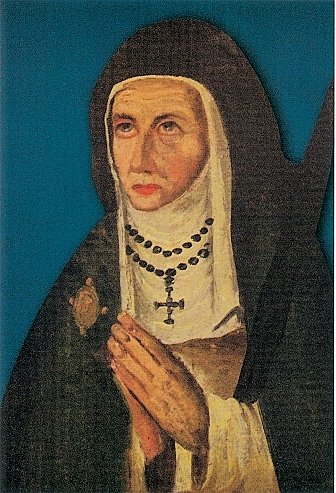This is the amazing story of the miraculous image of Our Lady of Czestochowa, that was attacked by Hussite heretics and survived due to intervention of Divine Providence – even by a bolt of lightning.

Tradition tells us that Saint Luke, an able painter, responding to the requests of many Christians, who wanted to preserve a remembrance of the Blessed Virgin Mary after her elevation into Heaven, painted her sacred face on an oak table, near which Our Lady used to sew and pray.
Some time later, when the Romans dominated Jerusalem and were destroying many churches, Divine Providence protected the icon from falling into the hands of the pagans. The relic, carried to Constantinople by the Empress Saint Helena, hidden by the Christians, always received divine protection, when that city fell into the power of the oriental emperors and under the dominion of the unbelievers for centuries.
In its constant pilgrimage, we find the image, in the year 802, in the chapel of the Belz, in White Russia. In those days, there were many marriages between members of the Byzantine and Russian nobility, so the icon was probably given as a wedding present in one of those marriages.
When in the second half of the fourteenth century, Louis, the Hungarian King of Poland and Hungary, annexed White Russia to his dominions, the Castle of Belz was confided to Prince Wladyslaw of Opole (Silesia). In that epoch, Ruthenia was submitted to the continuous incursions of the Tartars, and in one of those invasions, the Castle of Belz was besieged by the pagan hordes.
The defense became increasingly difficult and the defenders threatened to give in. Prince Wladyslaw was praying before the altar on which the picture of Our Lady rested, begging her assistance when an enemy arrow struck the face of the Virgin, leaving a scar. The ancient chronicles say, broad daylight was transformed into dark night. Fear seized the Tartars. The prince sallying forth with his knights to the open plain, overthrew the Tartar hordes.
On seeing how insecure Belz was, and wishing to avoid the possible destruction of the beautiful picture, Wladyslaw decided to transport it to Opole, in Silesia. And so he put the image in a splendid carriage drawn by six chargers, and began the long voyage through the territories of the Polish Crown, on the way to the land of his birth. But behold, when they arrived at the village of Czestochowa the powerful horses stopped and would not move from the place! Wladyslaw perceiving in this fact a sign from heaven went to the little chapel of the village, situated on top of the hill of Jasna Gora (Bright Mountain), where he gave himself up to prayer. Overcome by sleep, Our Lady communicated her desire to him in his dreams: Her image had to be venerated right there on Jasna Gora.
Without any delay, the picture was solemnly enthroned in the little church, while Wladyslaw gave orders for the construction of a church of greater dignity and scale in that place, and a monastery beside it. Later he would request sixteen Hungarian friars of the Pauline order whom he charged with the care of the relic. This took place in 1382.
The happy news soon spread all over the country and the historian Jan Dlugosz, who lived at the time, reports that pilgrims began to flow into Czestochowa from all the territories of the Polish-Lithuanian Crown, as well from Bohemia and Moravia.
The Attack of the Hussites
Good Friday night in 1430, a band of Czech Hussites, commanded by a Polish noble, also a Hussite (in nearby Silesia, this heresy had gained many followers among the nobles) attacked the sanctuary and killing five religious, seized the golden vessels and ornaments of the Church, some relics and the image of Our Lady, loading them all in a cart.
The chronicles of Jasna Gora tell us that immediately after descending the hill, the horses stopped and would not move from the place. Then, one of the heretics, cursing the picture, hurled it to the ground with such force that it broke into three pieces but the faces of Our Lady and of the Infant Jesus remained intact.
In the face of this, one of the Hussites took a sword and struck the right side of Our Lady's face twice, and when he raised his sword for the third blow, he fell fulminated by a bolt of lightning.
His companies fled in terror, but the chiefs of the band were caught and put to death by the sword. So profaned by the heretics, and abandoned in the midst of the slime, the holy picture was found by the Paulist friars.
When they bent over to pick it up, they saw a spring of crystalline water open underneath it and washed it of the dust and mud. In that place, at the foot of Jasna Gora, was placed a wooden cross, and later the Church of Saint Barbara was built there. In the interior of the temple, the spring continues to gush the miraculous water sought by the pilgrims and famous for the cures of eye diseases which it works.
The picture was then taken, at the request of King Wladyslaw Jagiello to Krakow to be restored. The best Polish artists dedicated their talent to the task, but a miraculous fact occurred: once the restoration was completed, the paint which covered the scars left in the faces by the sword blows of the heretics ran off! Italian artists called in later to restore it found that same phenomenon occurred with them.
Finally it was decided to make a copy of the original picture on a new canvas, preserving the wounds. This picture, however, is fixed to the original wood, which is considered to be a relic. (Nowadays there are three known copies of the picture done at the end of the fourteenth century, for the churches of Glogowek in Silesia, of Lepoglaw in Croatia and of Sokal; none of them since they were made before the attack of the Hussites, show the wounds in the face of Our Lady)
As a consequence of that attack, Wladyslaw Jagiello very nearly declared war on Bohemia. It was the fact that Polish nobles were also involved in the episode, which kept him from doing so. Those nobles, however, were severely chastised, and the historians of the epoch report that all of them died violently in the year following the profanation of the holy place.
Later, toward the end of the sixteenth century, King Zygmunt III, in order to give greater security to the sanctuary, built strong walls about it with four bastions constructed according to Dutch techniques, all surrounded by a moat and he provided a garrison maintained by the Crown. Thus Jasna Gora took on the aspect of a fortress. Against its walls in the following century, an invasion of the Swedish heretics would break up.
Replacing the rustic and primitive little church, there now rose a majestic one, with a high wooden tower. The work of its construction, in which King Wladyslaw Jagiello personally participated, lasted from spring until October for many years. In 1690, the tower burned and, falling on the nave, did great damage. In its place a new tower was built of wood, which was also destroyed by fire. In 1906, the present even more imposing tower of bricks and mortar was inaugurated. In that year, Pope Saint Pius X elevated the church - whose nave holds nearly 4,000 people - to the rank of Basilica.
To read more about the Seige of Czestochowa click here.
















